
The tamarins are squirrel-sized New World monkeys from the family Callitrichidae in the genus Saguinus. They are the first offshoot in the Callitrichidae tree, and therefore are the sister group of a clade formed by the lion tamarins, Goeldi's monkeys and marmosets.
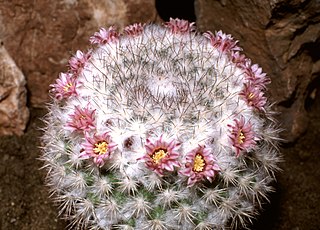
Mammillaria is one of the largest genera in the cactus family (Cactaceae), with currently 200 known species and varieties recognized. Most of the mammillaria are native to Mexico, but some come from the southwest United States, the Caribbean, Colombia, Venezuela, Guatemala and Honduras. The common name "pincushion cactus" refers to this and the closely related genus Escobaria.

The Caparaó grass mouse is a rodent species from South America. It is found in Brazil.
Hyloxalus mystax is a species of frog in the family Dendrobatidae. It is endemic to Ecuador where it is only known from its type locality on the Cordillera del Cóndor at 1,830 m (6,000 ft) asl. It is a little known species not observed since 1972.
The Moaif tree frog is a species of frog in the subfamily Pelodryadinae, endemic to West Papua, Indonesia. Its natural habitat is subtropical or tropical moist lowland forests.
Paul Garber is a primatologist and the author and editor of several books and articles about primates. He is a professor at the University of Illinois. He is editor of the American Journal of Primatology and director of research and education at La Suerte Biological Field School in Costa Rica. Books he has authored or edited include New Perspectives in the Study of Mesoamerican Primates: Distribution, Ecology, Behavior, and Conservation , On the Move: How and Why Animals Travel in Groups, Adaptive Radiations of Neotropical Primates. and South American Primates: Comparative Perspectives in the Study of Behavior, Ecology, and Conservation In 2014, he co-edited two books on howler monkeys. He has also studied interrelationships between the moustached tamarin and the saddleback tamarin.

Mammillaria spinosissima, also known as the spiny pincushion cactus, is a species of flowering plant in the cactus family Cactaceae, endemic to the central Mexican states of Guerrero and Morelos, where they grow at elevations of approximately 1,600 to 1,900 metres. The species was described in 1838 by James Forbes, gardener of the Duke of Bedford. Botanist David Hunt collected a specimen in 1971, when he located one near Sierra de Tepoztlan, Mexico.

Fucaria mystax is a species of sea snail, a marine gastropod mollusk in the family Skeneidae.

Gnathophis mystax, the thinlip conger or blacktailed conger, is an eel in the family Congridae. It was described by François Étienne Delaroche in 1809, originally under the genus Muraena. It is a subtropical, marine eel which is known from the eastern Atlantic Ocean, including southern Portugal, the Mediterranean, and Morocco. It dwells at a depth range of 75–800 metres, and inhabits mud and sand on the continental slope. Males can reach a maximum total length of 60 centimetres, but more commonly reach a TL of 35 centimetres.
Mystacophorus mystax is a species of beetle in the family Cerambycidae, and the only species in the genus Mystacophorus. It was described by Duvivier in 1891.
Ellopostoma mystax, the enigmatic loach, is a small, endangered species of freshwater fish originally placed in the family Balitoridae, but now generally in Ellopostomatidae.
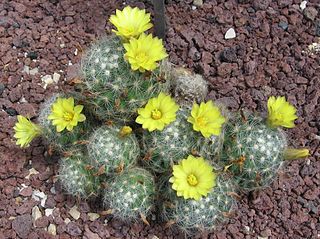
Mammillaria baumii is a species of cactus in the subfamily Cactoideae. It is endemic to Mexico. It was named for botanist Hugo Baum.
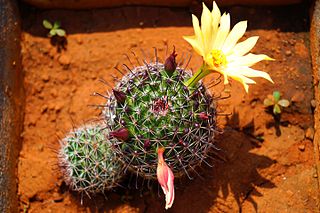
Mammillaria beneckei is a species of cacti in the tribe Cacteae. It is native to Mexico.
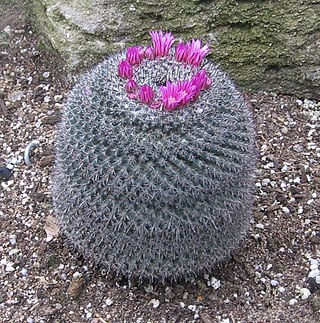
Mammillaria supertexta is a species of cacti in the tribe Cacteae. It is native to Oaxaca, Mexico.

Mammillaria heyderi is a species of cactus in the tribe Cacteae. It is endemic to Sonora and Chihuahua in Mexico and New Mexico, Arizona, and Texas in the United States.
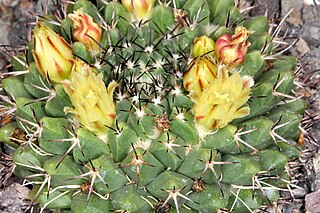
Mammillaria karwinskiana is a species of cacti in the tribe Cacteae. It is native to Mexico.

Mammillaria haageana is a species of cacti in the tribe Cacteae. It is native to Mexico, where it is found commonly, and is widespread throughout much of the country.
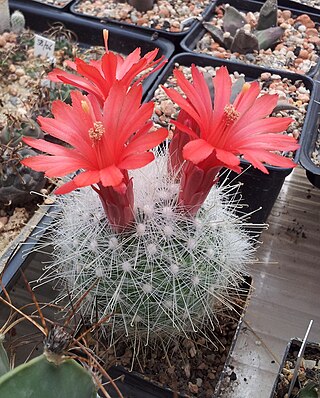
Mammillaria senilis is a species of cacti in the tribe Cacteae. It is native to Mexico, where it is found in the states of Chihuahua, Durango, Jalisco, Nayarit, Sinaloa and in south Zacatecas.

Mammillaria pringlei, called the lemon ball, is a species of cactus in the genus Mammillaria, native to Mexico, from Querétaro through to Veracruz and on to México State. It has gained the Royal Horticultural Society's Award of Garden Merit.

Mammillaria hernandezii is a species of cacti in the tribe Cacteae. It is native to Mexico where it has a disjointed distribution in a small area of upland tropical pine scrub. There are estimated to be fewer than 500 plants in the wild and is classified as endangered.
















